If You Catch a Tagged Sturgeon, Please Report Info to MN DNR
Category: article
Mar 25th, 2021 by Keith Worrall
Modified Mar 25th, 2021 at 12:43 PM
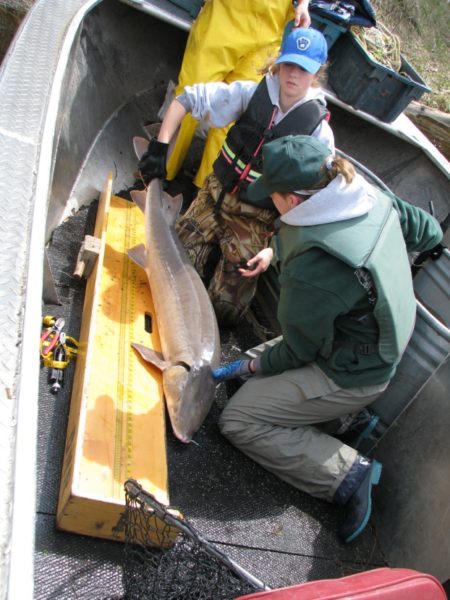
If You Catch a Tagged Sturgeon, Please Report Info to MN DNR
Article reprinted from the MN DNR
Six feet, that’s the length of the longest lake sturgeon tagged by the Minnesota Department of Natural Resources, and there’s a chance a Rainy River angler could catch that 6-foot fish or others out of the 8,959 sturgeon tagged to date as part of a long-term study.
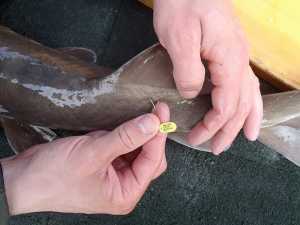
Tagged sturgeon, Rainy River“Spring sturgeon fishing on the Rainy River has been excellent,” said Phil Talmage, DNR Baudette area fisheries supervisor. “As if catching a lunker sturgeon isn’t enough, catching a tagged fish and reporting it gives anglers and the DNR an added bonus. Cooperation from anglers is an essential part of this long-term tagging and recapture study.”
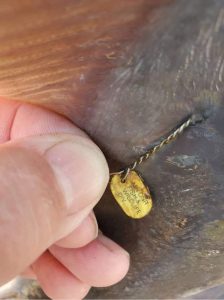
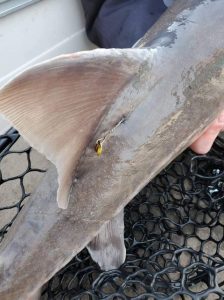
Anglers who report the tag number on a sturgeon receive an email back from the Baudette office thanking them, along with maps and information collected on their tagged fish and its history since tagged. The information tells a story of the sturgeon’s travels from when it was captured until it was caught and reported.
Of the 8,959 lake sturgeon tagged so far, 5,484 were longer than 45 inches at the time they were tagged. The longest sturgeon tagged was 72 inches – 6 feet – but weight was not recorded for this fish when it was captured on the Rapid River, near Clementson, in 2014.
The heaviest sturgeon tagged and weighed was 89.1 pounds, but only 63.5 inches long. This fish came from the Littlefork River in 2000. The largest sturgeon sampled was caught off of Pine Island in September of 2007. This fish was 73 inches long and estimated to weigh 120 pounds. Unfortunately, the DNR was not set up to tag this fish, so it was released without a tag. Tagged sturgeon, Rainy Rivertagged sturgeon 031921
“Our tagging program is part of an effort to monitor sturgeon as the population recovers,” Talmage said. “Besides understanding sturgeon movement and reproduction cycles, the tagging effort also allows us to make population estimates.”
Population estimates of the number of sturgeon longer than 40 inches in the Lake of the Woods-Rainy River system were made in 1990, 2004 and again in 2014. The sturgeon population grew from about 16,000 in 1990, to about 60,000 in 2004 and about 92,000 in 2014.
The Lake of the Woods-Rainy River system is one of the few areas in the country that has a sturgeon population that is healthy enough to support a fishery.
“In Minnesota we are fortunate that sturgeon are beginning to recover in most watersheds throughout the state,” Talmage said. “This has been accomplished though improving water and habitat quality, stocking to reintroduce the species and improving fish passage through dam removal and modifications.”
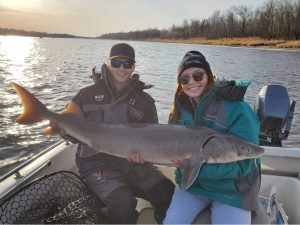
Emma Carlson, Oliver Lee, tagged sturgeon, Rainy RiverIntense commercial exploitation during the late 1800s and early 1900s decimated the once abundant sturgeon population in Lake of the Woods and Rainy River. After the decline of the commercial fishery, the sturgeon population was unable to rebound due to water pollution and degraded habitat in the Rainy River, the primary spawning area and nursery habitat for young sturgeon. But because sturgeon are extremely long-lived, enough individuals managed to survive and reproduction was sufficient to maintain a small population.
With the passage of clean water legislation in the late 1960s and early 1970s, especially the Clean Water Act in 1972, the sturgeon population started to recover as water quality and habitat conditions improved. Now reproduction is successful in most years.
In Minnesota, lake sturgeon are listed as a Species of Special Concern. What happened to sturgeon in the Lake of the Woods-Rainy River system also happened to many populations throughout the continent. In addition to water-quality and habitat degradation, the constructions of dams impacted populations throughout the world.
In the Minnesota waters of Lake of the Woods and Rainy River, anglers can catch-and-release sturgeon Oct. 1 through May 15 and July 1 through Sept. 30. Anglers who purchase a $5 sturgeon harvest tag can harvest one fish 45-50 inches inclusive, or over 75 inches in length, per calendar year: April 24 through May 7 or July 1 through Sept. 30. The sturgeon season is closed May 16 through June 30.
To report a tagged fish visit mndnr.gov/taggedfish or to report it directly to the Baudette office, find contact information and other management information at mndnr.state.mn.us/areas/fisheries/baudette.
For statewide sturgeon fishing regulations, visit mndnr.state.mn.us/regulations/fishing.
Click Here to view the Lake of the Woods Tourism website.
Click Here to view lodging on and around Lake of the Woods and the Rainy River.